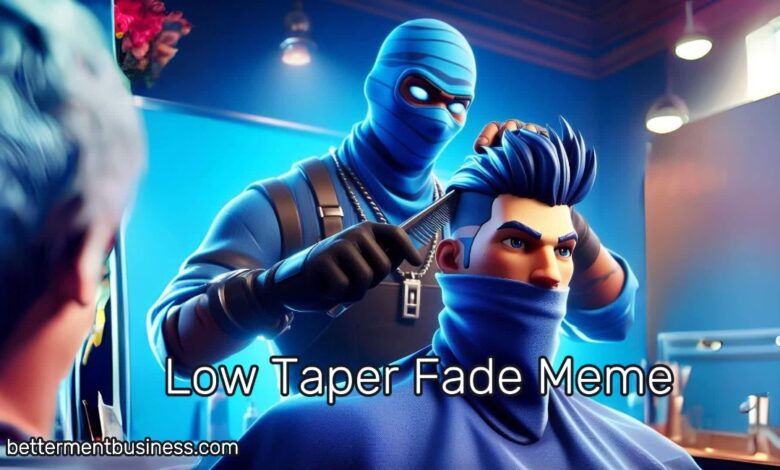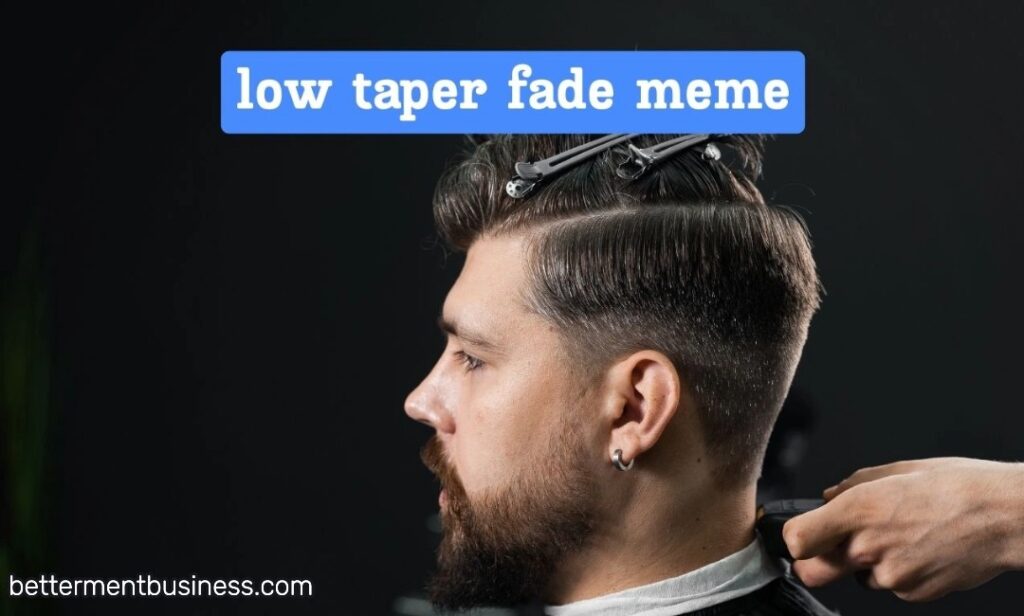The Rise of the Low Taper Fade Meme: A Haircut Trend Taking Over Social Media

Introduction to Low Taper Fade
The Low Taper Fade Meme is a popular hairstyle that has garnered attention in recent years, especially within various social media platforms. This haircut is characterized by a gradual transition of hair length from the top of the head to the nape of the neck, creating a smooth fade that begins lower on the head. Unlike other fading techniques that may start higher up, the low taper fade emphasizes a subtle yet distinct gradient, appealing to those seeking a more understated look. It can be styled in conjunction with various lengths and textures of hair on top, making it versatile for different hair types.
This hairstyle has its roots in traditional barbering culture, where skilled barbers utilized fading techniques to create clean lines and defined shapes that complemented an individual’s facial features. As it evolved, the low taper fade became more accessible to the general public, breaking down the barriers that once confined it to barbershops frequented by men. Today, it is embraced not only by young men but also by women and individuals of diverse demographics. This inclusivity has contributed to the trend’s significant rise in popularity, as it provides a contemporary way to express personal style.
The low taper fade has also found a prominent place in the realm of social media, where users often share images and videos showcasing their variations of the haircut. These creative expressions have led to the emergence of the low taper fade meme, highlighting the humorous and light-hearted side of hair culture. As a result, this specific fade style has transcended mere appearance; it has become a form of communication within online communities. In the following sections, we will explore the various subcultures that embrace the low taper fade and how it has transformed into a canvas for creativity and expression on social media platforms.
Understanding Memes: What Makes Them Popular?
Memes, succinctly defined, are ideas, trends, or styles that spread virally, often through social media platforms. The structure of a meme typically consists of an image combined with text, creating a humorous or relatable narrative that resonates with a wide audience. The inherent simplicity of memes enables quick dissemination, making them cultural artifacts that capture the zeitgeist of a particular moment or trend.
Several factors contribute to the virality of memes. Firstly, humor plays a crucial role; memes often evoke laughter by combining unexpected contexts, absurdity, or relatable experiences. In the case of the low taper fade meme, the hairstyle’s distinct look, combined with amusing captions or scenarios, amplifies its appeal. Memes benefit from relatability, as they often tap into shared experiences that audiences can connect with, fostering a sense of community and engagement.
Visual appeal is another significant factor in a meme’s success. Eye-catching images are more likely to attract viewers’ attention, leading them to share the content further. The low taper fade haircut, known for its sharp and stylish appearance, serves as an ideal subject for meme creation. The clarity and precision of this hairstyle lend themselves well to humorous comparisons or exaggerated portrayals, ensuring that the visuals resonate with a diverse demographic.
Moreover, cultural commentary also plays a part in why certain hairstyles, such as the low taper fade, become meme material. Stylistic trends that are representative of current societal norms or youth culture can easily be transformed into memes that offer commentary, delight, or insight into generational attitudes toward appearance and identity. This fluid exchange between hairstyles and meme culture fosters an ongoing dialogue, consequently propelling trends like the low taper fade into popular recognition.
The Intersection of Haircuts and Humor
The fusion of hairstyling and humor has become a prevailing trend on social media platforms, illustrating how something as personal as a haircut can become a source of collective amusement. Haircuts, particularly the low taper fade, serve as a common ground for individuals to create and share humorous content, enabling creative expression and social bonding. The low taper fade meme specifically exemplifies this phenomenon, as it has gained traction through relatable visual puns that resonate with a broad audience.
Social media has transformed the way people engage with hairstyles, making it possible for users to capture and share images of their haircuts instantly. This immediacy fosters a playful environment where creativity flourishes, allowing users to craft jokes or memes featuring various haircuts. Consequently, the low taper fade, with its clean lines and stylish finish, has become an easy target for comedic interpretation. The versatility of this haircut lends itself well to humorous scenarios, making it a staple for meme creators.
Moreover, the low taper fade meme exemplifies the power of visual humor in engaging audiences. The haircut often represents an aspirational aesthetic, yet its depiction in meme culture can highlight the contrast between expectations and reality. When users see exaggerated representations of the low taper fade, they not only engage with the humor but also reflect on their experiences related to hairstyling and identity. As a result, this haircut becomes a lens through which people can comment on broader societal themes, from self-image to cultural stereotypes.
Ultimately, the intersection of haircuts and humor manifests in the burgeoning meme culture surrounding the low taper fade, where laughter serves as a bridge connecting individuals over shared experiences and ideas. The ongoing evolution of this trend reflects the dynamic nature of social media, where humor and personal style coalesce in unique and entertaining ways.
Notable Low Taper Fade Memes
The low taper fade meme has taken the internet by storm, particularly across social media platforms such as Instagram, Twitter, and TikTok. One of the most memorable examples of this trend features a classic image of an individual sporting a stylish low taper fade haircut, accompanied by humorous captions that play on the transformation theme. The juxtaposition of the precise haircut against everyday scenarios promotes relatability and a sense of community among viewers who appreciate grooming styles. This meme often highlights moments of significant self-improvement, thus appealing to a wider audience.
Another notable instance of the low taper fade meme can be traced back to its incorporation in various challenges and trends, where users share before-and-after pictures showcasing their fresh cuts. These memes not only celebrate the artistry involved in hairstyling, but they also deliver laughter by exaggerating the dramatic effects of a haircut. Social media users frequently utilize hashtags like #LowTaperFade or #FadeGameStrong to enhance the reach of their posts, allowing for a collective interaction among those sharing similar grooming experiences.
Cultural references within the low taper fade meme are significant as well; many creators draw inspiration from television shows, movies, or popular figures who exemplify the low taper fade. For instance, some memes reference characters known for their iconic hairstyles, further cementing the haircut’s status as a symbol of coolness. Such references help to forge connections between the low taper fade haircut and broader sociocultural narratives that resonate deeply with audiences. As the low taper fade continues to trend, it is expected that memes will evolve, keeping pace with changing styles and shifting societal perceptions.

The Role of Influencers in Popularizing the Trend
The emergence of the low taper fade meme and its subsequent popularity is significantly influenced by social media platforms, where visual content reigns supreme. Influencers, particularly those within the grooming and fashion sectors, have played a pivotal role in this phenomenon. Their ability to engage large audiences makes them key players in shaping hairstyle trends, and the low taper fade is no exception.
With platforms such as Instagram, TikTok, and YouTube serving as primary channels for showcasing grooming styles, influencers have harnessed humor and relatability to connect with their followers. By creating entertaining content that features the low taper fade, they have effectively made it a meme in its own right. Video tutorials demonstrating the haircut or comedic skits juxtaposing different styles have garnered millions of views, amplifying the haircut’s appeal.
Furthermore, trendy hairstyles, like the low taper fade, often serve as conversation starters in these videos, allowing influencers to share personal stories or relatable experiences. This strategy fosters a sense of community among viewers, nudging them to experiment with the style themselves. Barbershops have also joined the conversation by showcasing their work on social media, which further popularizes the trend. Many barbers share before-and-after photos of clients sporting the low taper fade, often accompanied by humorous captions that play into the meme culture.
The strategic partnership between influencers and barbers creates a cyclical effect: as influencers popularize the low taper fade meme through engaging content, barbers gain visibility for their skills in executing the cut. This collaboration not only enhances the humor associated with the trend but also fuels the demand for the low taper fade haircut. In this digital age, the power of influencers in shaping style trends cannot be overstated, and their comedic approach facilitates the ongoing ascent of the low taper fade within pop culture.
Cultural Impacts of the Low Taper Fade Meme
The low taper fade meme has emerged as more than just a popular hairstyle; it encapsulates significant cultural dynamics surrounding identity, representation, and community bonding. As this haircut trend proliferates across social media platforms, its visual representation and the accompanying memes highlight the evolving attitudes toward self-expression and aesthetics within various communities. The low taper fade, characterized by a gradual tapering of hair length on the sides and back, has become emblematic of a fresh, clean, and stylish look that resonates with diverse demographic groups.
Social media spaces have played a crucial role in popularizing this haircut. Memes featuring the low taper fade often reflect shared experiences, humor, and cultural references, fostering a sense of belonging among those who identify with this style. For many, participating in these meme exchanges goes beyond admiration for the haircut itself; it signifies a connection to a wider cultural narrative that embraces individuality while also adhering to certain societal norms associated with grooming and aesthetics. These memes serve as a medium through which individuals express their identities, transcending geographical and cultural boundaries.
The low taper fade meme also invites discussions about representation in hair trends, particularly in how it reflects evolving standards of beauty across different cultures. The increasing visibility of this hairstyle in meme culture contributes to its normalization, allowing for a broader acceptance of what is deemed fashionable. As a hairstyle that originated within specific cultural contexts, the low taper fade has sparked conversations about appropriation, authenticity, and the commercialization of cultural symbols. In this way, the low taper fade meme not only highlights individual style but also acts as a catalyst for deeper discussions about identity and community. Through its proliferation, we can observe how a simple haircut becomes a lens through which larger societal constructs are examined and understood.
Creating Your Own Low Taper Fade Meme
The low taper fade meme has surged in popularity across various social media platforms, becoming a symbolic representation of personal style and cultural expression. To create your own iteration of this trending meme, it is essential to understand both the structure of a successful meme and how to leverage your unique perspective.
First, consider the format. Memes often rely on a striking image—ideally, one featuring a low taper fade hairstyle. You can use your own photos or find royalty-free images that depict this haircut. Pair the image with text that resonates with common experiences or cultural references. A touch of humor can go a long way, so think about relatable scenarios or exaggerated stereotypes associated with the low taper fade. For instance, you might create a meme contrasting the expectations versus the reality of trying to achieve the perfect low taper fade.
Next, choose your platform wisely. The ideal medium for sharing your meme can greatly influence its reach. Platforms like Instagram and Twitter are particularly effective for humor-driven content. Utilize appropriate hashtags, such as #LowTaperFadeMeme or #FadeFam, to enhance visibility and engage with others who appreciate this particular hairstyle. Furthermore, TikTok and Snapchat are excellent choices for video memes that can amplify the humorous context surrounding the haircut.
After creating your meme, engage with your audience. Respond to comments and share behind-the-scenes insights on your creative process. This interaction not only fosters a community around your content but also encourages others to share their own low taper fade memes. Ultimately, your individual interpretation of the low taper fade can contribute to the hilarious discourse surrounding this haircut trend, making it uniquely yours.
Future of Low Taper Fade in Meme Culture
The low taper fade meme has carved out a notable niche in contemporary social media, and its trajectory suggests a promising future intertwined with the evolution of grooming trends. As social media platforms constantly adapt and innovate, the hairstyles showcased within these spaces often reflect broader cultural shifts. The low taper fade, characterized by its gradual transition in hair length from top to side, has become a versatile style embraced by diverse demographics. With its aesthetic appeal and ease of maintenance, this particular fade is likely to sustain its relevance in the world of hairstyling.
Moreover, the meme culture surrounding the low taper fade is expected to evolve as new meme formats and trends emerge. As users continue to create and share humorous or relatable content about this haircut, it will inevitably spark further discussions and creativity within social media circles. The versatility of the low taper fade also contributes to its longevity; it readily adapts to various social contexts, making it a conducive subject for memes. From playful takes on hair etiquette to comparisons with other popular hairstyles, the potential for the low taper fade meme to transform is substantial.
In addition to these stylistic themes, the future may witness the integration of advanced digital tools and platforms, enhancing how trends like the low taper fade are presented and perceived. Appointment scheduling apps and virtual try-on technologies may further popularize this haircut, leading to an influx of meme content particularly aimed at younger audiences. As these technologies develop, they can help fortify the low taper fade meme’s standing within the broader context of social media trends. Therefore, it seems likely that the low taper fade will remain a prominent figure in meme culture, flourishing under the spotlight of social media innovation.
Conclusion: Why the Low Taper Fade Meme Matters
The low taper fade meme has emerged as a notable trend within contemporary social media culture, drawing attention to the inherent connection between humor, identity, and community. This haircut style, characterized by its clean lines and gradual fade, has not only transformed personal grooming routines but has also become a canvas for creative expression in the digital realm. By examining the low taper fade meme, one can appreciate how it transcends mere aesthetics to encapsulate broader social themes.
At its core, the low taper fade meme reflects an important aspect of modern identity. Social media platforms serve as a stage for users to showcase their individuality, and the low taper fade provides an appealing grooming option that resonates with many. Its versatility allows individuals to tailor the haircut to their unique preferences while simultaneously participating in a collective trend. Such shared experiences foster a sense of belonging within communities, reinforcing connections among individuals who appreciate the meme’s humorous undertones.
The humor associated with the low taper fade meme not only entertains but also serves as a means of coping with life’s challenges. Memes that highlight everyday experiences, like visiting the barber for a low taper fade, can evoke laughter and relatability. Moreover, they enable users to find camaraderie through shared scenarios, encouraging engagement across diverse demographic groups. As such, the low taper fade meme exemplifies the ability of humor to bridge gaps between people, providing a platform for both self-expression and community building.
In conclusion, the rise of the low taper fade meme is a testament to its significance in contemporary culture. It encapsulates the fusion of identity, humor, and community in the digital age, underscoring how a simple haircut can foster connections and spark joy among individuals worldwide.
Also Read bettermentbusiness.com
